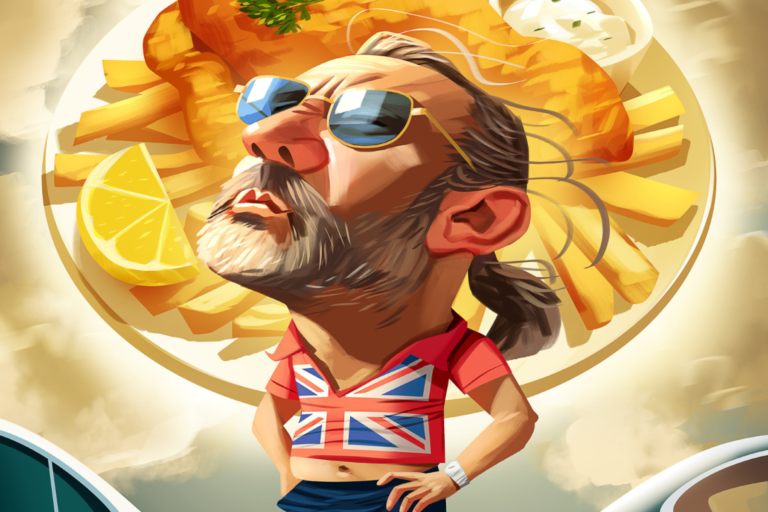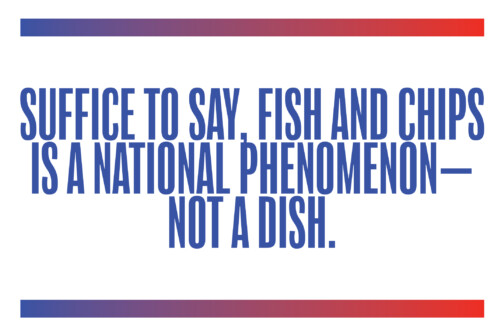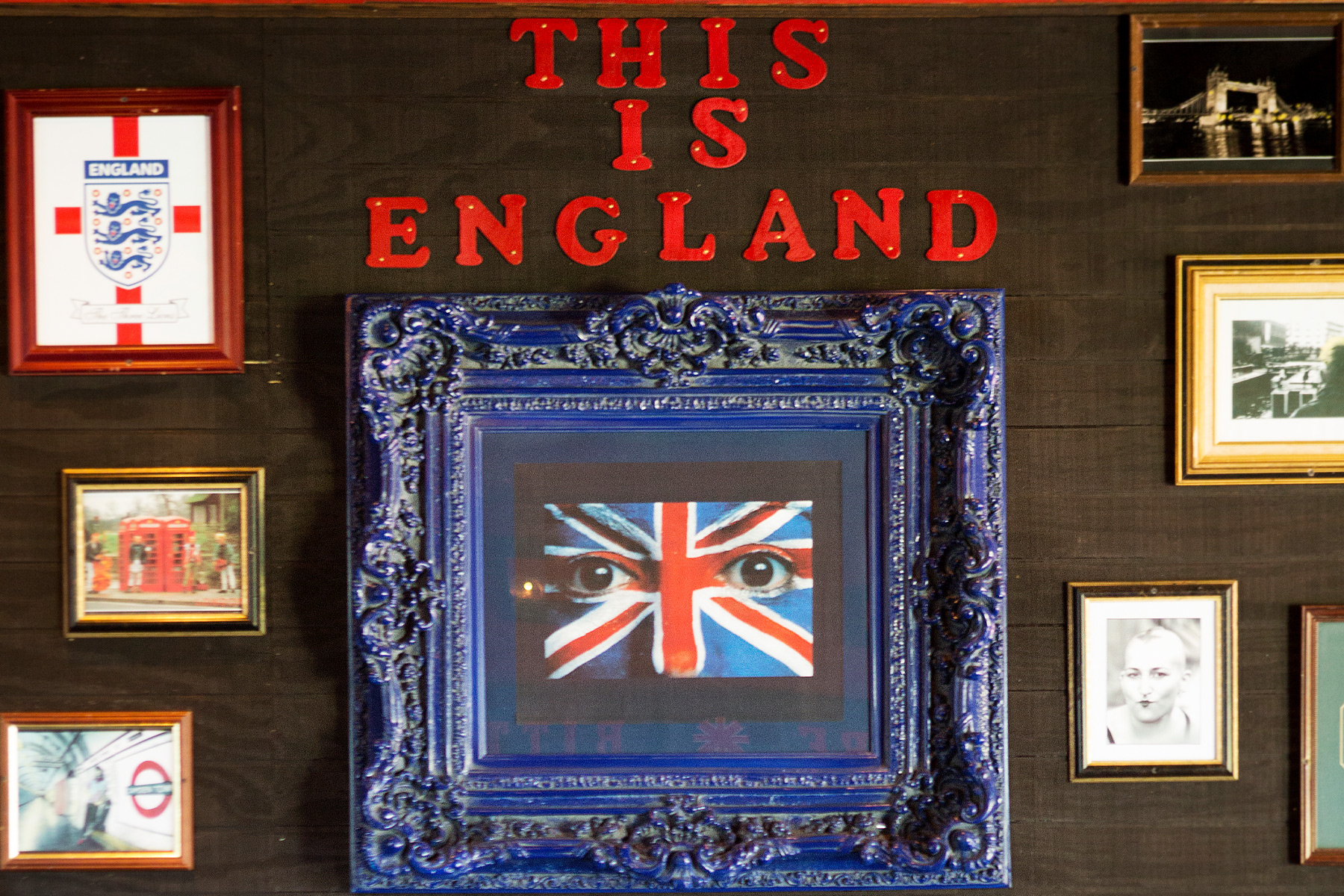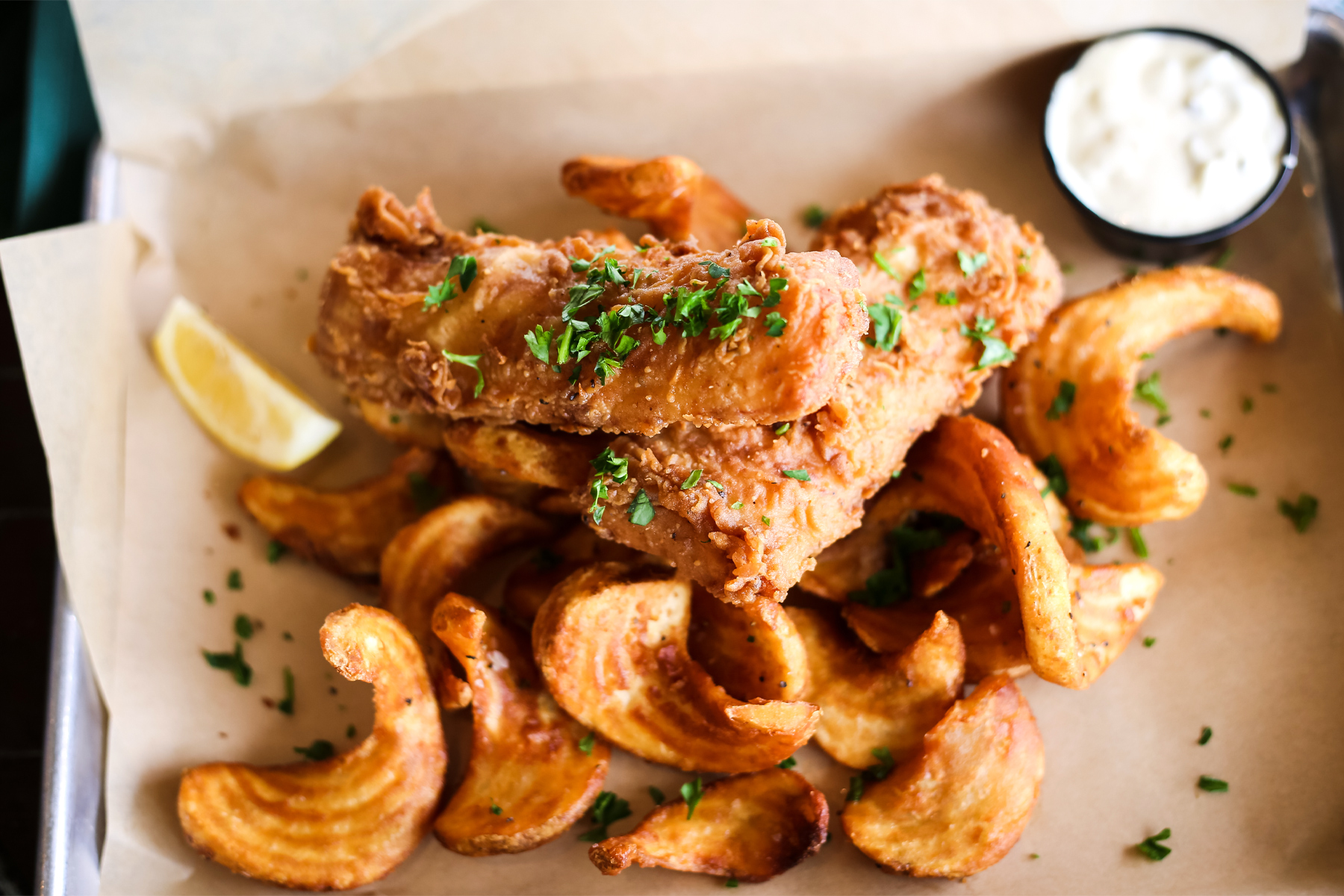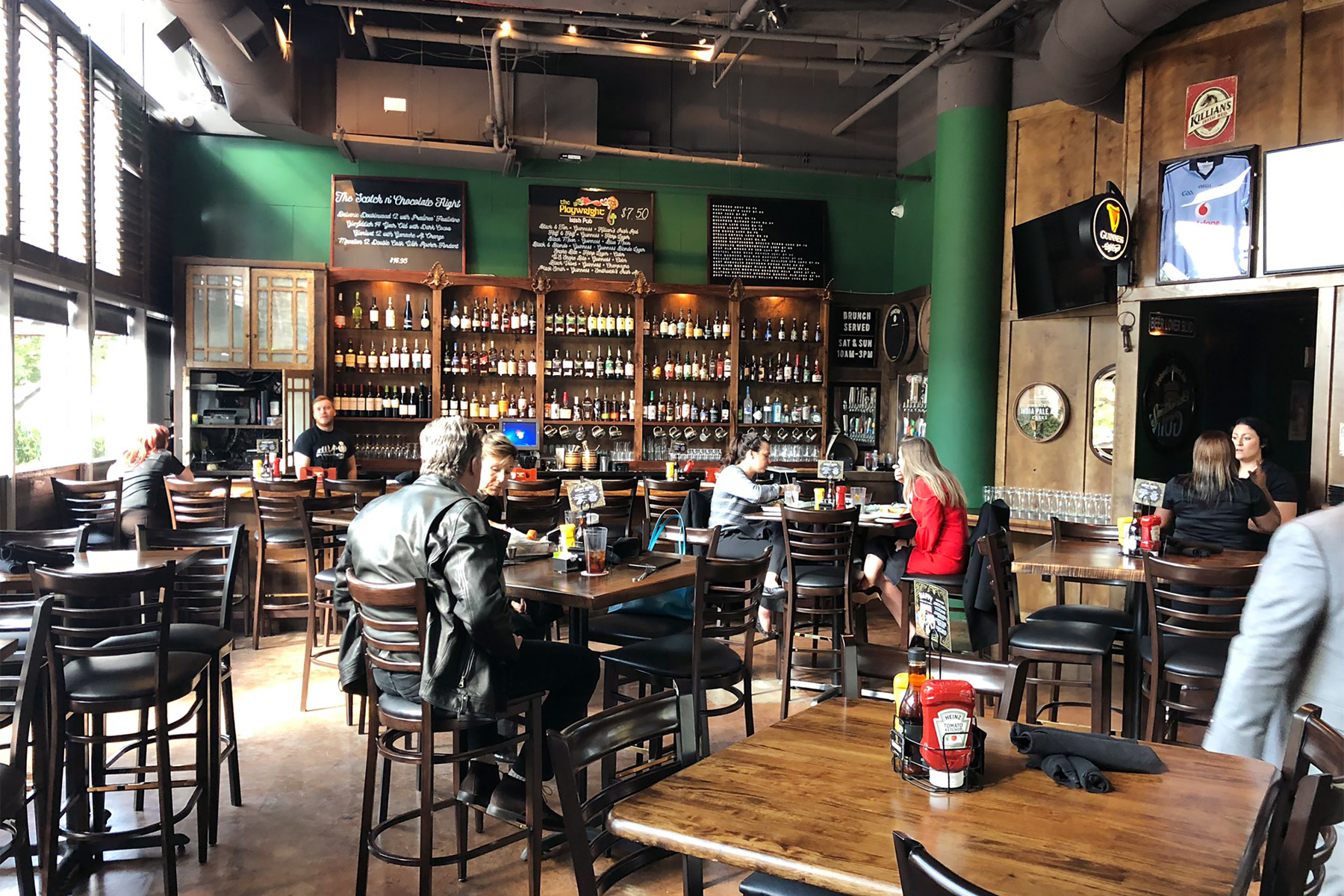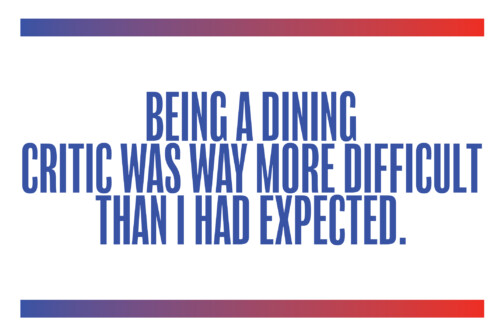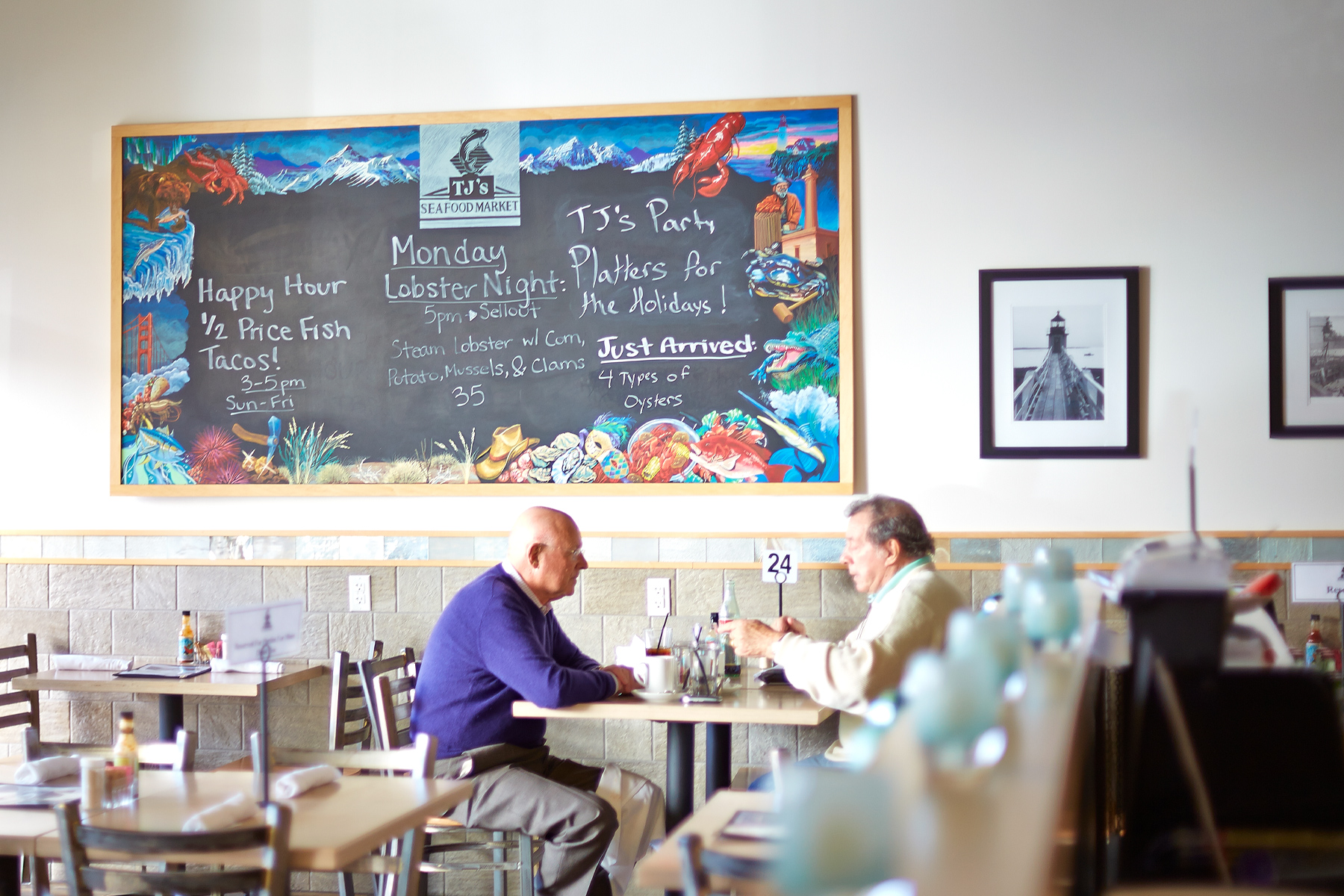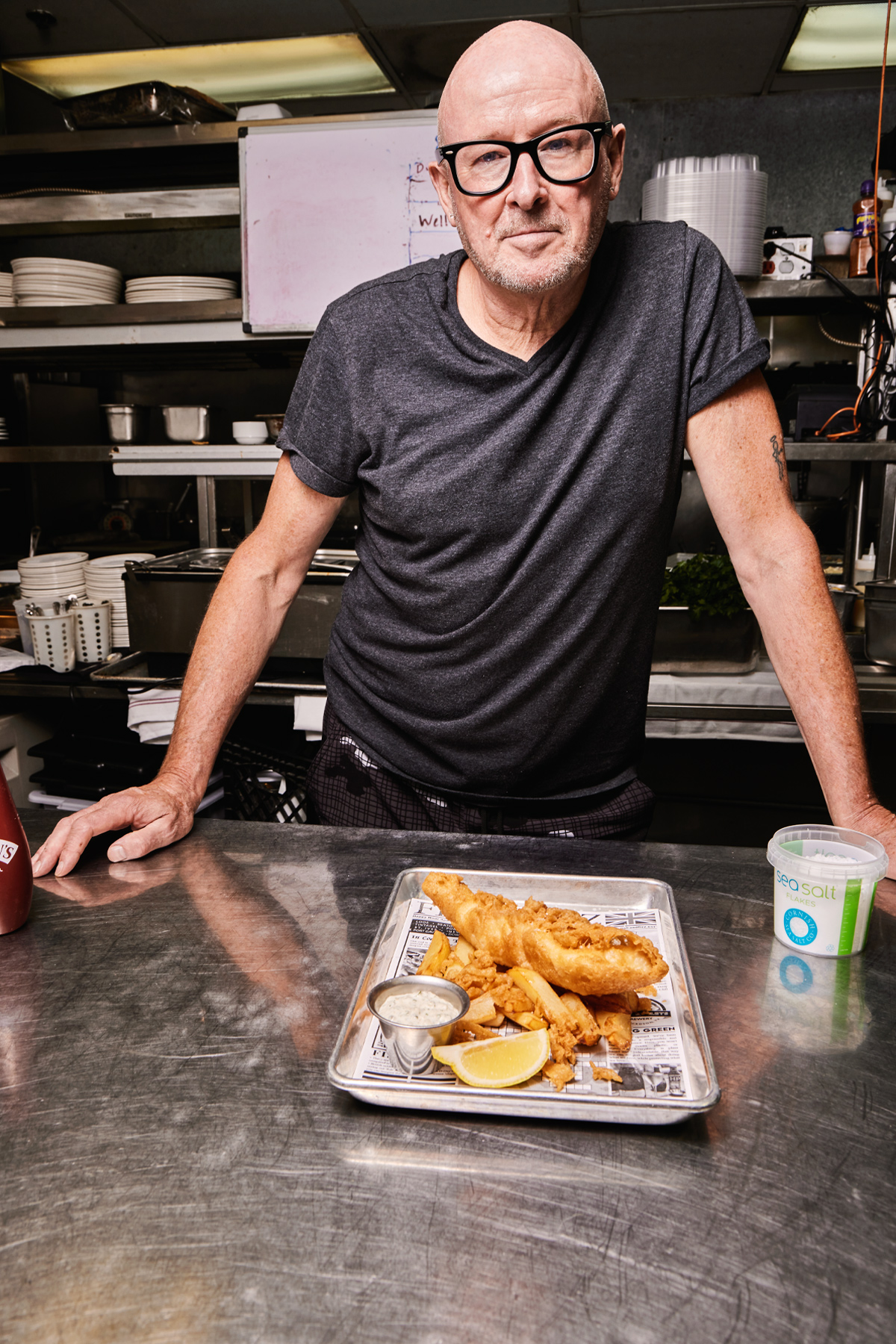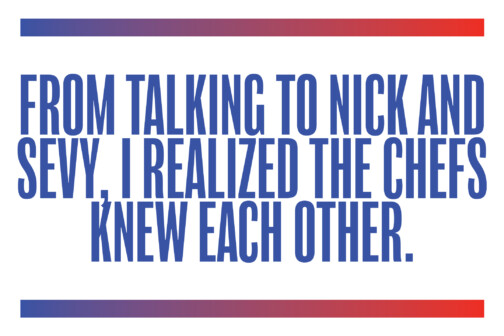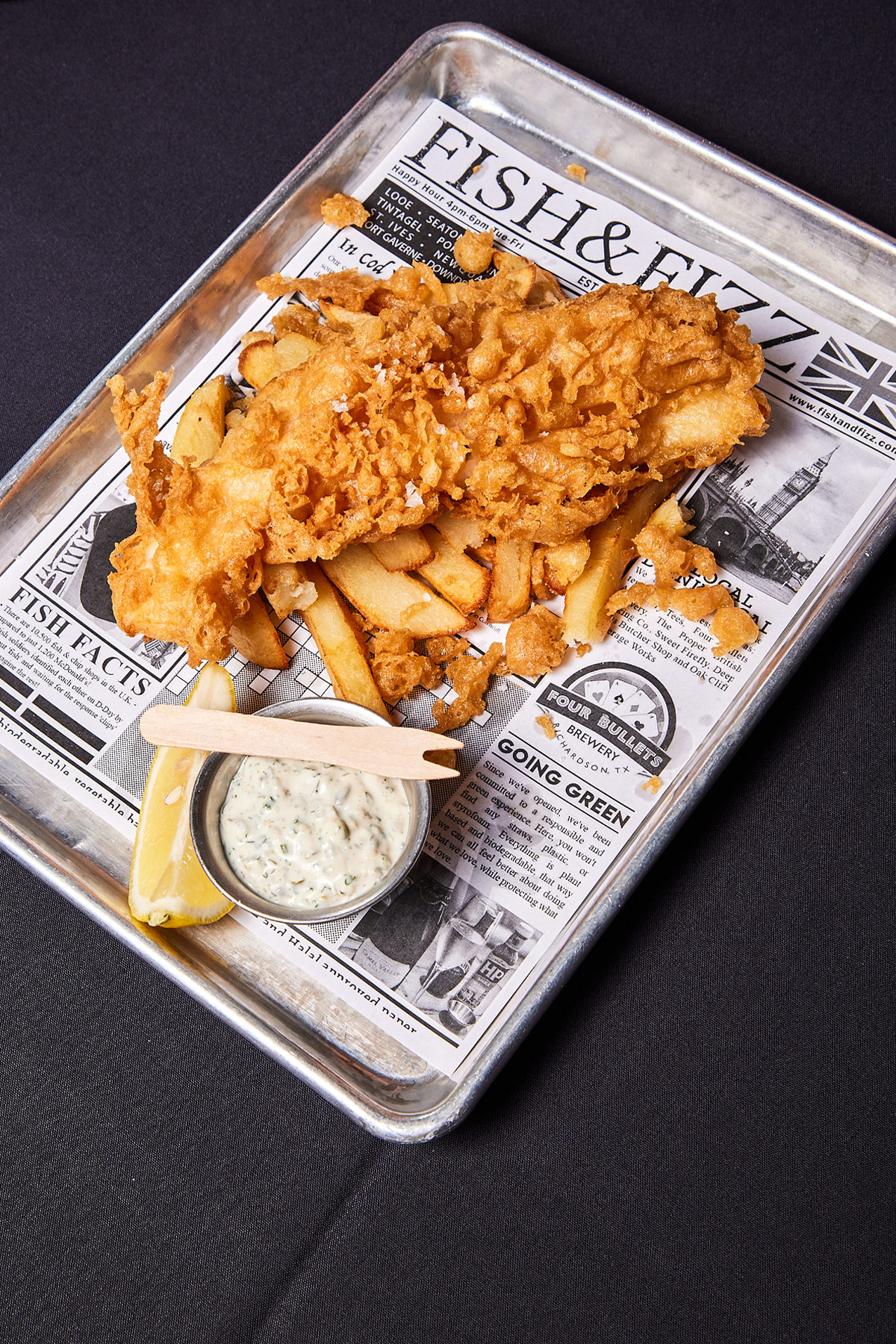We were at a dinner party for six at South Side on Lamar. Our host was an art collector. The subject of my home country’s culinary tradition came up.
“British cuisine?!” exclaimed a young, disbelieving Dallas lawyer. The two words were surely an oxymoron. “British cuisine? Like what? Like, fish and chips? Is that it?”
“Lamb!” I blazed back across the rim of a powerfully laced cocktail glass as a wrong-footing semi non sequitur. In footballing terms, I’d just nutmegged him. “Americans simply don’t understand lamb! The London restaurant scene is on fire right now! Fergus Henderson, Jeremy King—” The words hung meaninglessly in the air before phtting into last week. No one knew who I was talking about.
And so continued one of the most childish dinner-party spats I’ve had in my life—childish on both sides, I’d have to admit, as I contemplated defending my country’s cooking all the way back to Elizabethan times but then gave up and tore into a third cocktail instead. It was all rather silly and a long time ago, 15 years or so.
Yesterday, I was invited to one of the most memorable and lovely lunches I’ve had in all my time in Dallas, at Sevy’s Grill, on Preston Road. I will return to this meal after a few words.
“What were you leaving?” asked Amy Severson, wife of Jim “Sevy” Severson. She meant when I left England for America, as if I was perhaps on the run, needing to escape something.
I thought for a moment. No one in my two decades in Dallas had ever put it to me quite like that.
“My entire country,” I said. “I was leaving my entire country.” And then I launched into a longer answer about love and art and so on.
I’d found my way to Sevy’s after an esteemed editor friend of mine suggested I write about food, since nary a day passes without my writing an official letter to him about something I’ve eaten. He replied one morning and said, “Fish and chips.”
And like the young attorney, I said, “Fish and chips?! You want me to write about fish and fucking chips?! Let me sleep on it.”
Suffice to say, fish and chips is a national phenomenon—not a dish. It’s fish. And it’s chips. It is my country. Not the best or only representation of it, nor of its cuisine, but it’s an incredibly noble, egalitarian, and honest representation of it. Of course there’s all the other stuff, the literature, the music, the architecture, the navy, engineering, and so on. It’s like that line in Life of Brian when John Cleese, playing Wise Man No. 1, asks, “What did the Romans ever do for us?”
Like a steak or any other simple food, with fish and chips there are sublime versions and lousy versions and everything in between. Everyone knows a good fish and chips from a bad fish and chips back home. Geographically, you’re never more than 70 miles from the coast, and you’re probably rarely a mile or two from your local chippy.
So began my personal Dallas Fish and Chips Odyssey. It lasted three weeks, during which time I crisscrossed the city and beyond, retracing much of my time here, all undertaken in the baking, late-summer triple-digit heat when anyone with any sense and money is in Colorado, Tuscany, or Provence. At one point, I consulted Feargal McKinney, a native of Dublin and the owner of The Old Monk, on Henderson. I’d already eaten too many fish and chips. I was struggling. On the phone, I said, “I have to tell you, Feargal, I was thinking of starting this piece with the line ‘Forgive me, Father, for I have sinned.’ ” To which he replied, without skipping a beat and in his lovely, uncorrupted, lilting accent, “And for your penance, my son, you will be eating fish and chips in Dallas every day for a month.”
That young lawyer, by the way—he ended up becoming the current mayor of Dallas.
Saturday, August 19
My Odyssey started inauspiciously, almost accidentally. I’d had a long-planned engagement, almost a business meeting, with the esteemed editor, a man called Tim, to watch one of the opening matches of the English Premier League season. (Watch out, America. Football is coming for your football.) Spurs defeated Man United, but we won’t dwell on that.
We’d decided to meet at The Londoner at Mockingbird Station. The Londoner happened to be one of the venues on my fish and chips target list. And it was a late morning game, so I ordered their fish and chips. I was pleasantly surprised. I’d say it was not at all bad. But I like to focus on the game. And I like to focus on my food. And you can’t do both at the same time. And I really don’t like sports bars, and this, despite being called a British pub, is basically a type of sports bar.
This British pub from the outside is 1990s Mockingbird Station modern and generic. There’s no transition between the contemporary Dallas exterior and “British ye olde” interior, no airport lounge or customs zone where you are technically between countries, just an inch or two of exterior wall and glass. Outside, it’s Dallas. You step through the door, and it’s all London pub and horse brasses and full English breakfast and cockney geezer, Mary Poppins—only it’s not at all. Only someone who’d never left Dallas County would think this is remotely like England.
Still, the fish and chips were a very decent and honest effort. It was less daft than its predecessor, Trinity Hall, I feel duty bound to add.
One down, at least another 10 to go. It was about 110 degrees outside. Walking from pub back to the parking lot in such heat after fish and chips is, er, Not At All British.
Saturday, September 1
My second time out was far more challenging and strangely stressful. I realized that due to the pressure of my day job as an aging Young British Artist, I had a limited time to get through as near a dozen venues as I could manage in probably little more than two weeks. This meant fish and chips almost every day, and Feargal’s joke about penance was possibly not so much of a joke. I was on my way to his Old Monk, in fact.
Parking my Jaguar tends to make me panic under the best of circumstances. I hate my car getting dinged up in parking spaces designed for golf carts, despite the fact America has for over a century now built cars twice the size of anyone else’s. The Monk’s parking lot was not the best of circumstances.
I wore my official 2018 navy England football shorts and a t-shirt that looked very “athletic” when I was 20 pounds lighter, before the pandemic, but is now short and tight enough to reveal 2 inches of bare stomach if I’m not diligent about pulling it down, like women do with their skirt hems.
I walked in. I knew I was looking like Will Ferrell in the “More Cowbell” skit. Plus, I’d forgotten my reading glasses. Fortunately, I didn’t need them because I didn’t need to look at the menu.
“Fish and chips, please. And the IPA on the blackboard,” I bluffed to the 28-ish-year-old server. “And if you don’t mind, I have a couple of quick questions.”
She was very nice, very helpful. She was fairly sure the fish was fresh and would ask the kitchen about the variety of potatoes.
“They’re Sysco’s,” she announced on her return.
“That’s a variety?” I asked.
“Classics,” she said. “Sysco’s classics.”
Confused, I decided this was a rare Italian variety, maybe Sicilian or Greek or something. She went to fetch my beer. I held my phone as far away from my face as possible and tried to google “Syscos.”
My server returned with the beer. She clarified that Sysco is, in fact, a brand of restaurant food distributor, not a variety of potato, but seemed of the opinion that in the Darwinian order of things—genus, species, etc.—brand trumped variety in any case. Sysco classics.
I persisted. “Could you ask the kitchen if they know the variety of potato that Sysco’s classic steak fries use?” She came back unsure. I offered, “Russets, maybe? These seem to be the popular choice.”
She seemed a bit bored with this by now. “Er. You know, classics. Classic potatoes. The brown ones.”
It was one of the best lines on my Odyssey, I have to say. And the server was adorable and actually very helpful. And the chips turned out to be the second-most realistic shape of all the ones I tried and not bad tasting.
So. That was two done. I was exhausted. I drove home in the heat to have a couple of beers to decompress. Being a dining critic was way more difficult and stressful than I’d expected. At least no one had hit my Jag again.
For the sake of space, I can’t detail every voyage in the way William Sitwell does in the The Telegraph, where you enjoy his train ride to the coast, the Uber ride through the small village, the short walk across the footbridge, down the cobbled street and to the quayside 30-seat gastropub in a 400-year-old building. The first quarter of his review is taken up like this, so you’re already hungry as you kind of eat along with him as he describes his plates.
Almost all my Sitwell-esque Dallas journeys start the same way: I get in my Jag, I drive onto the highway on-ramp near my house in Exposition Park, and I head up Central Expressway. Much of my Odyssey is basically like this, so there’s no point in beating it to death.
Thursday, September 7
The day before we ventured to McKinney, the esteemed editor asked, “You wanna take your Jag or my Tesla?” I said that I was terrified we’d be nudging up against the Oklahoma border and something bad would most certainly happen to my Jag up there, so I insisted he drive.
We arrived in the charming old part of town and pulled up directly outside The Celt. Tim parked the Tesla next to a Tesla, after waiting for a woman in a Tesla to vacate the spot he wanted. The Celt is in a century-old building, a proper old-fashioned two-story townhouse across from a historic courthouse. While the interior is probably quite new, the feel of the place is cozy and old, and the bones of the building are reassuringly ancient and well built. We ate upstairs, near an unlit fireplace. The barman was knowledgeable. He answered my basic questions easily. It was the only place to offer a curry sauce—nice touch. We shared a plate, since we had to hit two lunch spots on the bounce. A lunch of two halves, as we say in football.
Next it was on to Delaney’s Irish Pub & Scratch Kitchen, 6 miles away or so. As we headed past the courthouse, a woman stopped traffic on West Virginia Street by simply jaywalking at a rakish, long diagonal and wearing a cobalt blue seersucker tank maxi dress with spaghetti straps. She was about 6 feet tall and looked like a Helmut Newton model, like Elle Macpherson in Sirens. It was a vision. I rather thought Tim hadn’t braked but that the Tesla’s computer had taken over because Elon had programmed into the pedestrian safety feature a “Sirens” mode, whereby all the magnets in the electric motors disengaged and the car came to a silent and immediate stop—more a salute than a stop, in fact. We had no option but to just sit there and watch her walk the full length of the panorama, framed by the windshield. The backed-up cars behind us watched and waited patiently. Elon’s computer restarted the car once her back heel was on the sidewalk, and the Tesla whirred effortlessly forward. Tim claimed he was operating it, but I didn’t for a minute believe him.
Delaney’s was situated in a spot polar opposite to The Celt. It’s one of those ubiquitous new strip malls carved out of the dirt, with limestone cladding that’s meant to be a bit classier than the non-limestone ones but makes me want to slash my wrists no matter what. I was hoping the food would be awful so we could cut and run. The place was massive, with TVs in abundance. The food was surprisingly good, however, and it was the only place on my Odyssey to offer fish and chips made with haddock. This is no small thing.
Friday, September 8
Next up was Friday in the Arts District, in the much vaunted One Arts Plaza casual venue called The Playwright, owned by Alan Kearney, an Irishman. I was at the point where I was doing back-to-back fish and chips and was trying to pace out lunches and dinners, so I split the difference on this one and headed out at happy hour, around 4 pm. The heat was unrelenting. I parked slightly remotely in the large One Arts parking lot and felt fleeced, with no option but to park the entire day at $9 or something. I’d already driven the length of Flora, but despite the deserted streets, mysteriously all the free parking was taken.
As I got out of my car, I felt that I was hallucinating in the insane heat. I could hear distant bagpipes. As I neared The Playwright and rounded the corner, to my great surprise, there was an Irish piper in a glengarry bonnet, a black wool jacket, heavy wool socks, a kilt, the whole shebang. He was playing short reels and jigs to no one at all. As I approached the door, I saw businesspeople sardined inside and a sign on the door saying “Private event until 6 pm.” With no other bar or “normal” place to slip into, other than the nearby 7-Eleven, I decided I could either forfeit my $9 parking and come back in two hours or go and see some art to fill some time.
It wasn’t an easy decision, but I decided to knock on director Jeremy Strick’s door at the Nasher Sculpture Center, feeling much like a bored teenager in the middle of the long summer break, like Huckleberry Finn rattling a stick along a white picket fence, looking for company and something to do in an otherwise deserted landscape.
Jeremy wasn’t in, the receptionist informed me. “What about Jed, then?” I asked, by now kicking an imaginary empty can and reaching for the slingshot in my back pocket. Maybe now is a good time to mention that I am on the Nasher’s program advisory committee. “Jed’s downstairs somewhere,” I was told.
I went down and encountered Jed Morse, respected chief curator. Inside the big fish tank gallery, Leigh Arnold was working on a women’s land art exhibition she was curating. Leigh joined us, and I monologued for barely 60 seconds on fish and chips before she became anxious and left us, but Jed stood fast, and I bored him for a full two hours. I figured if ever there was a good time to impart some of Book 1 (there are two books) of my life story, it was now, in the punishing desert heat, in the bowels of Renzo Piano’s cooling and tranquil travertine marble building, a kind of oasis of civility and calm.
By 7 pm I was losing my voice and in need of ale. Jed let me out of the Nasher, and I made my way back toward The Playwright. It was still hot as hell, still no one on the streets. The food at The Playwright was better than most. Really not bad.
Tuesday, September 12
This was Meddlesome Moth day, and I again elected a midafternoon tasting. No one was in there. I drove around not wanting to valet, but there was no option. Unlike at Neighborhood Services, where they parked the Jag right outside the front door, at Meddlesome Moth they put my car between an old pickup truck and some sort of blobby car. What was the point of valeting? I thought. Why couldn’t I just park on the street and walk? At least put me next to a Lambo.
Kudos to Shannon Wynne for serving mushy peas, the only place I tried that did so. Nil points, though, for not getting it even vaguely right. Wrong peas, apparently some sort of peas “concept.” I hate the word “concept” in reference to food and restaurants. I’d put that along with the Irish piper in full Celtic woolens in 110-degree heat. Sorry. Got to be honest.
Wednesday, September 13
It’s getting grueling now. Feargal’s “penance” is starting to weigh heavy. Driving up Central on my way to TJ’s Seafood Market, I tried to calculate how many Hail Marys are in a single Dallas fish and chips trip. A hundred? More maybe?
I learned their fish is provably fresh, since there were skinless cod fillets for sale in their fresh fish cabinet, and their batter was made of cornstarch and all-purpose flour. It was an interesting batter, by far the most crisp, but I didn’t particularly like it. Many, I’m sure, will like it, but it wasn’t what I was looking for. The fish had good flavor, but if I’m comparing it to fresh top-notch cod in England, it was a bit ordinary. Still, TJ’s was up there in the best three, along with Neighborhood Services and, perhaps surprisingly, The Celt in McKinney, sort of the Brighton FC of the entire Dallas league.
Thursday, September 14
Finally, the weather had broken, and it had rained that morning. I arrived on McKinnon Street, headed to Harwood Arms, with an overcast sky and 15 degrees cooler. I parked on the side of the street you’re allowed to park on. For some reason unknown to man, the 10 feet of available sidewalk had been divided into fake grass rugs that sort of spilled out clumsily like a student’s unmade bed onto the concrete. The rain had washed mud from the adjacent townhome projects and under the grass rugs. The only way to get to the crosswalk was to wade through an inch of mud in my new $100 orange-and-pink Vans, which only days earlier had been admired by the leading aesthete and seasoned Nasher curator Jed Morse. I was about to arrive at the pub trailing mud across the floor like I’d just escaped a yearlong famine and a tempest all at once.
I crossed the road and found Harwood Arms, which has a totally faked-up exterior. Inside it was dark, with loads of screens showing baseball and dude bros wearing baseball caps. I remembered why, like Gustav Klimt, I never left my house except for emergencies.
A server delivered this line after I asked if the fish was flash frozen: “It’s gonna be fried. It’s fried codfish.” Like she thought I was expecting sushi and chips? I’d learned to let some of it go at this point.
Not terrible. Again, not bad, decent. OK.
Outside, I found a pedestrian crossing free of mud, only there was no light on this one, just the zebra stripes across all five lanes. I waited, and then waited some more. As I waited, I realized that if only I looked like the woman in McKinney with the cobalt blue dress and Elle Macpherson’s figure, then I could just step into the street, and the traffic would automatically stop.
Eventually I reached my car. I got in and texted the esteemed editor Tim: “I’ve eaten at Harwood Arms. Please never make me come back to Uptown ever again. I hate it here.” He texted back, “Actually, technically, that’s the Harwood District, not Uptown.” As if this made a difference.
Friday, September 15
This was the day of the Big Lunch at Sevy’s to which I promised at the beginning of this story that I would return. I was heading up Central once more, this time to meet some of Dallas’ leading chefs for what promised to be the gold standard of fish and chips—not just in Dallas but perhaps anywhere.
Early in my quest, the esteemed editor had put me in touch with Sevy, so that I might hound him with technical questions about the supply chain of high-quality fish. Sevy, after educating me for nearly an hour, said I needed to talk to Nick Barclay. Then he went one further: “Nick needs to come and cook you his fish and chips in my restaurant. Leave it to me. Here’s Nick’s number.”
Nick is a countryman, the onetime proprietor of Fish & Fizz, in Richardson, which closed earlier this year after Nick failed to negotiate satisfactory lease terms. By the time I reached him on the phone, he said, “Sevy just called me. I’m cooking fish and chips at his place.” We set a date and then talked for 90 minutes, mostly about cars. And then, the following day, we talked for another 90 minutes.
Nick filled in the gaps of how he came to Dallas and started Barclay’s, which closed more than 20 years ago and is still missed. He told me about Martin Lombard opening the Tipperary Inn on Skillman Street, which preceded Mucky Duck, a pub for rugby fans and expats. Then Feargal and Peter Kenny from Ireland arrived in the early 1990s via New York, opening The Dubliner, and a new type of Irish/British pub took hold in Dallas, offering British comfort food and perhaps a more convivial and social ambience.
From talking to Nick and Sevy, I realized that most of the chefs and pub owners knew each other, in some cases had worked for each other or consulted. Their industry ran parallel to mine, the art world. Of course there was competition, but there was support, too.
All of this was running through my head as I drove up the highway, playing the Rolling Stones’ best song in 40 years, “Don’t Get Angry With Me,” which Nick and I had briefly discussed on the phone after I’d only half-jokingly likened Nick, Peter, Feargal and company’s arrival in Dallas to the 1960s British Invasion of the Who, the Kinks, the Rolling Stones, the Yardbirds, the Beatles.
I valeted at Sherry Place at 1:30 pm and walked in wearing double denim—what Texans like to tell me is the Canadian Tuxedo, but which Canadians call the Texan Tuxedo—and my Norton biker t-shirt, pulled tight over my belly. I was directed to the private party room to the side of the restaurant, where four people were already waiting. I realized, appropriately enough, it was fish on Friday. This was it. The 10 Hail Marys had been said. It felt auspicious and grand.
“Richard?” asked Sevy from 10 paces, beaming and clearly proud. We shook hands. On one side was his wife, Amy; next to him, the Godfather of Dallas’ dining scene, Dean Fearing; and then Nick Barclay, as British as you like, with a CV that extends back to Grosvenor House on Park Lane, in London, and a City & Guilds apprenticeship. Fearing’s credentials, I feel sure, need no introduction.
As Nick and I shook hands, his first words were “Hackney diamonds!”—a statement to the room, a statement of intent but also a reference to the title of the Stones’ new album and ironic slang for the broken glass of a shattered windshield left by the curbside.
More guests arrived: Lisa and Richard Chamberlain, of Chamberlain’s, a tall and elegant man in a very cool dark blue Nehru jacket; Michael “Buzzy” Zeve, a partner of Sevy’s who interviewed for Fearing early on and about whom Fearing joked, “The only chef ever to interview wearing a coat and tie”; and Cris Worley, the gallerist representing me in Dallas.
We sat down. Nick believes proseccos and Champagne go best with fish and chips. I’d never thought of this before, but he’s right. The bubbles appeared. We all exchanged stories, like how those of us who weren’t from Dallas arrived here and why we’d stayed.
The fish and chips appeared, each serving set on newsprint, on Nick’s Fish & Fizz rectangular aluminum trays. Cod. And. Chips. Tartar, Sarson’s vinegar, and a small wooden fork, like you’ll see in takeouts in the U.K. Nick appeared from the kitchen to see if everything was to our liking and then joined us.
A round of applause rippled around the table. Think about this: this was Nick’s 46 years of experience in kitchens around the world brought to bear on one of the oldest and simplest of foods, fried potatoes and fried fish. And here was a panel of Dallas Dining Gods, applauding in acknowledgment of what this truly meant.
How do I describe the food? Perfection. Additional words aren’t needed.
As we ate, Dean told a wonderful story about a man seen stuffing muffins into his coat pockets at one of his signature restaurants. The muffin man turned out to be one of the country’s leading billionaires, who was so taken with them that Dean was summoned to cook him a series of private dinners. The first guest at the first dinner was Margaret Thatcher.
I told a story about the mega London chef Mark Hix cooking a private dinner for 30 at my dealer’s house after one of my openings, only no one told me it was Mark until after everyone had gone home. Nick said, “Mark and I apprenticed together back in the day.”
I’d become quite emotional. The purity and the perfection in Nick’s fish and chips, the respect of his fellow Dallas chefs, for both the lunch and the man, and the mutual respect they all had for each other was tangible. It reminded me that no man is an island. Any world—the art world, the dining world—is made of groups of people interacting, co-dependent and pushing each other forward and challenging one another. The quest for making the perfect fish and chips reminded me of my own quest to make the perfect painting. It doesn’t have to be fancy, or complicated. It just has to be exactly right. And more: it has to respect the tradition it came from. It has to know and respect the canon.
I said, “A question for the assembled chefs: was there a moment when you feel the Dallas scene peaked, when you knew it was at its zenith and truly rocking?”
The answer from Dean came back: “Yes. From about 1997 to 2005.” He said the financial crash changed things. Dean noted the golden years were chef-driven, whereas now it was more about branding. This was precisely like the art world, whereby the cultural dialogue has disappeared and has been replaced by amorphous branding led by faith (read: money) only in the name of mega galleries. The art world has become (hopefully temporarily) a faceless place only about financial investment.
But here I sat around a room with seven other faces, “tickets,” as Pete Townshend would have called them in Quadrophenia. In London’s mod culture of the 1960s, to be a Face, to be a Ticket, was to be “someone.” It meant you had to have real charisma and that you had to be really good at something.
Fish and chips. The best fish and chips you can’t get in Dallas is Nick Barclay’s.
“The last unadulterated dish out there,” said Nick. “It’s just fish, potatoes, flour, and water.”
What a complete and utter pleasure. Like I’d returned home. Like Homer, my Odyssey was finished.
This story originally appeared in the November issue of D Magazine with the headline, “Fish and Chips Odyssey.” Write to [email protected].

